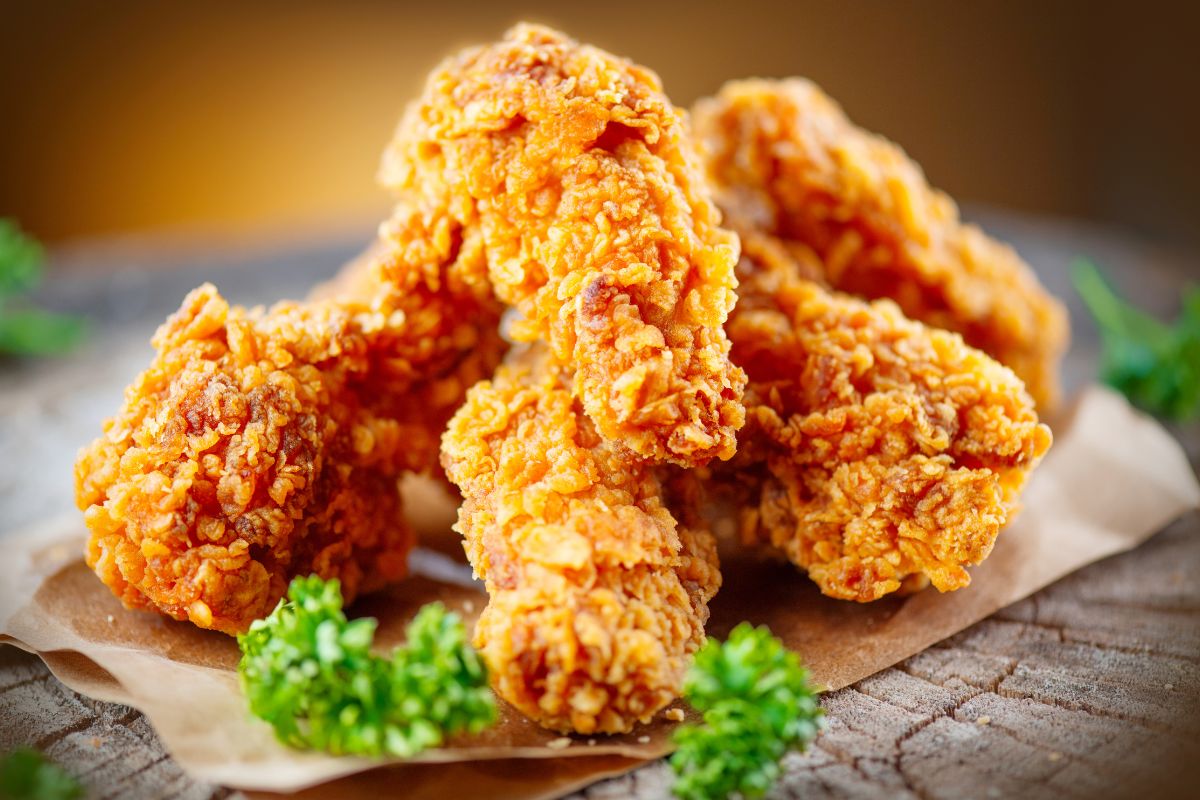How to Make Crispy Fried Chicken at Home

Golden, crispy exterior and tender, juicy meat. In the American South especially, this crunchy treat is a point of pride – its “crispy, golden skin and tender, juicy meat” are part of the reason it’s “especially beloved” there. Making fried chicken at home lets you control the ingredients and seasoning, so you can achieve that perfect crunch (and flavour) in your own kitchen. Whether you grew up with a family recipe or are trying it for the first time, the payoff is a plate of mouthwatering chicken that’s crisp on the outside and juicy inside.
Essential Ingredients
-
Chicken pieces: Bone-in chicken parts like thighs, drumsticks, wings or breasts. (Dark meat pieces are often juicier, but mix them however you like.)
-
Buttermilk (or marinade): A buttermilk soak is classic for fried chicken. As Food & Wine notes, marinating the chicken in buttermilk with salt, pepper and a touch of cayenne for 2–4 hours really ensures juicy meat. (If you don’t have buttermilk, a quick brine of salt, sugar and water works too.)
-
Flour and cornstarch: All-purpose flour is the base of the dredge. Many cooks boost crispness by adding some cornstarch (and even a pinch of baking powder) to the flour. This blend creates a light, crunchy crust as it fries.
-
Spices and seasonings: Salt and pepper are a must. Common additions are paprika, onion powder, garlic powder, and a bit of cayenne or hot pepper flakes for heat. These can be mixed into the marinade and into the flour coating. (Food & Wine’s recipe, for example, adds cayenne to the buttermilk and to the flour to give the crust extra flavor.)
-
Oil: Use a neutral oil with a high smoke point, such as peanut, canola or vegetable oil. These oils can heat hot enough (around 325–350°F) without burning. (Avoid extra-virgin olive oil or butter, as they smoke at frying temperatures.)
Step-by-Step Instructions
-
Marinate the chicken. In a large bowl or container, whisk together buttermilk (or plain milk plus a tablespoon of vinegar) with salt, pepper, and any spices you like (paprika, cayenne, garlic, etc.). Submerge the chicken pieces and refrigerate for at least 2 hours (overnight is even better). This soak tenderizes and flavors the meat. (If you prefer, you can instead brine the chicken in a solution of water, salt and sugar for 30–60 minutes.)
-
Mix the coating. In a large shallow bowl or paper bag, combine the flour with seasonings: a good pinch of salt and pepper plus garlic powder, onion powder, paprika, and a little cayenne for spice. For extra crunch, add about 25–30% cornstarch by volume to the flour (and even ½ teaspoon of baking powder). Mix well so the dredging mix is uniform.
-
Dredge the chicken. Remove a piece from the marinade and let any excess drip off. Working one piece at a time, thoroughly coat the chicken in the flour mixture, pressing the flour onto the surface so it sticks. Shake off any loose flour. For an ultra-thick, craggy crust, you can perform a double dredge: after the first coating, dip the chicken back into the buttermilk (or beaten egg) and coat it again in flour. (Food & Wine even recommends letting each floured piece rest on a rack for about 30 minutes after coating—this helps the crust set and adhere.) Arrange the coated chicken pieces on a wire rack while you finish breading the rest.
-
Heat and fry. Pour oil into a large heavy pot (cast iron is ideal) to a depth of about 1–2 inches and heat to 350°F. You want the oil hot enough that a little flour sizzles immediately, but not smoking. Fry the chicken in batches without crowding the pot (about 2–4 pieces at a time, depending on size). Maintain the oil temperature around 325–350°F—overcrowding the pan or adding very cold chicken can drop the heat, causing greasy coating. Fry each batch until the crust is deep golden brown, turning once or twice. This takes roughly 15–18 minutes per batch; use an instant-read thermometer if unsure (white meat should reach ~165°F internally).
-
Drain and rest. Use tongs to remove the chicken from the oil and let it drain on a wire rack set over a baking sheet. (Do not pile it on paper towels—paper will steam the hot chicken and make the crust soggy.) Let the fried chicken rest for 5–10 minutes; the crust will crisp up further and the juices will redistribute. Then serve immediately, or keep warm in a 200°F oven for up to 15 minutes before serving to maintain crispness.
Tips for Extra Crispiness
-
Use Cornstarch (and Baking Powder): Adding cornstarch to the flour coat makes the crust especially brittle and light. Baking powder helps too—it creates tiny air pockets in the crust as it fries. Many top cooks mix these right into the dry dredge for a super-crunchy shell.
-
Double-Dredge (Thicker Crust): For a really hefty crust, coat the chicken twice. After the first flour coating, dip the pieces again in buttermilk or beaten egg and then into the flour mixture a second time. This builds a craggier, crunchier crust that stays ultra-crispy.
-
Double-Fry (Korean-Style): Try the Korean method: fry the chicken once until just cooked through, let it cool slightly, then fry it a second time until extra-golden. This second fry (usually another 12–15 minutes) makes the exterior super crunchy. Korean fried chicken is often finished with a sweet-spicy gochujang glaze, giving it a sticky, spicy coating.
-
Let the Coating Set: After dredging, rest the chicken on a rack for 20–30 minutes before frying. This drying time helps the flour adhere and form a more robust crust as it hits the oil. You can even refrigerate the breaded pieces briefly to help the crust bind.
-
Maintain High Oil Heat: Keep the oil between about 325 and 350°F. If the oil is too cool, the chicken will absorb excess oil and turn greasy. If it’s too hot, the exterior will burn before the inside cooks. Use a deep-fry or instant-read thermometer to monitor temperature. Fry in small batches to avoid crowding, which cools the oil and yields soggy chicken.
-
Drain on a Wire Rack: Always drain the fried chicken on a wire rack (over a tray) instead of on paper towels. This prevents steam buildup under the chicken that would soften the crust. Let the chicken sit a few minutes on the rack—it will crisp up while cooling just a bit.
Variations
-
Spicy Fried Chicken: For a heat kick, up the cayenne or chili powder in the dredge, and mix hot sauce (like a good Louisiana-style hot sauce) into your marinade or batter. One recipe suggests boosting cayenne to 1 tablespoon and adding ¼ cup of hot sauce to the batter. You can also toss the cooked chicken in Nashville-style cayenne butter or chili oils for even more spice after frying.
-
Korean-Style Chicken: Double-frying is key here. After the first fry and a brief rest, fry the chicken again until ultra-crispy. Then coat the pieces in a sweet-and-spicy sauce made from gochujang (Korean chili paste), garlic, soy sauce, and honey. The result is sticky, crackly fried chicken that stays crunchy even under the sauce.
-
Gluten-Free Fried Chicken: Swap the all-purpose flour for a gluten-free flour blend (like a 1:1 baking mix) and use cornstarch or potato starch in the coating. For example, one gluten-free recipe uses GF flour plus cornstarch in the batter, and it produces “a perfectly crispy golden brown” crust. (Ensure your seasonings and any sauces are also gluten-free.) The technique is the same otherwise.
Common Mistakes to Avoid
-
Frying Cold Chicken: Don’t fry chicken straight from the fridge. Let the marinated chicken warm up to room temperature for about 20–30 minutes first. Cold chicken can dramatically drop the oil’s temperature, leading to uneven cooking and a limp crust.
-
Skipping the Soak: Forgoing a brine or buttermilk soak is a fast track to dry meat. Even a few hours in a seasoned buttermilk or saltwater bath makes a big difference in juiciness. If you’re short on time, a quick brine is better than nothing.
-
Neglecting the Coating Steps: Don’t skimp on breading. Each step (flour, egg/buttermilk dip, and flour again) helps build flavor and crunch. Also, season every layer: sprinkle salt (and a little pepper) between layers if possible. Shaking off too much flour before frying can actually yield a thinner crust. Instead, pack the dredge on well—it cracks and crisps beautifully that way.
-
Wrong Oil or Pan: Using a low-smoke oil (like olive oil) is a mistake—it burns at frying temps. Also, don’t use a shallow pan with too little oil; aim for at least 1–2 inches of oil depth. A heavy pot (Dutch oven or cast iron) helps the oil temperature stay steady.
-
Overcrowding or Eyeballing Oil: Avoid putting too much chicken in the pot at once. Crowding lowers the oil temperature and causes greasy, unevenly cooked chicken. Use a thermometer and hold the oil around 325–350°F. If pieces fry unevenly, lower the heat a bit or cook in smaller batches.
-
Cooling on Paper Towels: Right after frying, don’t dump the chicken onto a paper-towel-lined plate. As Bon Appétit warns, the towels will trap steam and make the crust soggy. Always drain on a wire rack so air circulates under the chicken and keeps it crisp as it cools.
In the end, fried chicken is as much art as science. Be patient with the process: proper seasoning, coating, and oil temperature are key. With a little practice (and the tips above), you’ll be rewarded with golden, crackling fried chicken every time. Serve it hot, enjoy the satisfying crunch, and don’t be surprised if it’s even better the next day (cold fried chicken has its fans, too!). Happy cooking!






